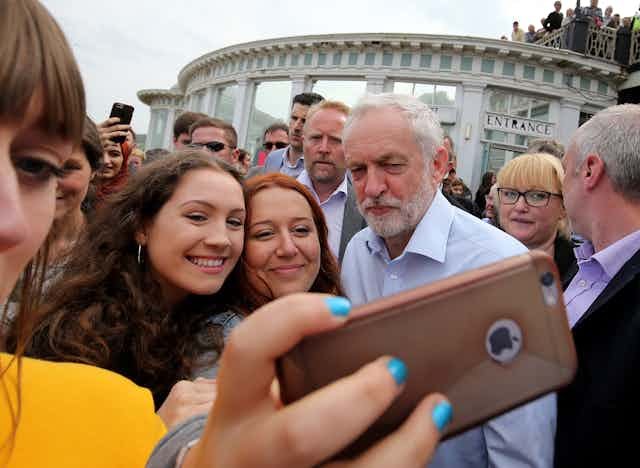Academics from the British Election Study have labelled the 2017 youthquake in British politics a “myth”. They argue that when adjusting for “demographic imbalances”, there is no evidence of a substantial change in the relationship between age and turnout between the 2015 and 2017 UK general elections.
This conclusion certainly differs from a number of other findings. Figures from Ipsos MORI, for example, suggest turnout among 18-24-year-olds for last year’s general election represented a 21 percentage-point increase from 2015.
This figure is derived using Ipsos MORI’s pre-2017 methodology; their newer methodology estimates an increase of 16 percentage points.
To consider (and dismiss) the idea of a youthquake solely on the basis of turnout is rather narrow. Indeed, according to the Oxford dictionary definition, youthquake is a multi-faceted phenomenon involving fundamental social, political and cultural shifts. Turnout is only one part of it.
Labour’s year
The Labour Party was emphatically ahead of all other parties among 18-24-year-olds in the last election. Putting forward a radical “youth-oriented” socioeconomic agenda, Labour effectively neutralised the threat posed by its progressive rivals such as the Green party and the Liberal Democrats.
Labour took a 62% vote share among 18-24-year-olds. Such a large vote share is unprecedented when looking at party support among young people in previous elections. In 2010, the two major parties were locked together in terms of support among this age group. The importance of age as an individual-level predictor for vote choice in 2017 should not be downplayed.
University-led youth revolt
A fascinating part of the youthquake was the swathe of young people supporting Labour in university towns and cities. No doubt spurred on by the promise to abolish tuition fees, young people in these areas voted for Labour in their droves.
The constituency of Canterbury, with a high concentration of students which include those who attend the University of Kent, elected a Labour MP for the first time since the seat’s creation in 1918 – removing its 30-year Conservative MP Julian Brazier in the process.
Meanwhile, former deputy prime minister Nick Clegg – vilified by many for his u-turn on tuition fees while in government – was unceremoniously dumped out of his student-loaded Sheffield Hallam seat by Labour.
Despite this being a crucial element of the youthquake, the BES paper does not deeply engage with levels of turnout and Labour support among young people in university towns and cities.
Young women
The role of younger female voters in the youthquake must also be noted. There was an unexpected gap in participation between young women and men aged 18-24 (66% to 62%). Younger women were also more likely to vote Labour than their male counterparts by some margin.
In the UK, a country which voted Brexit when the majority of young people wished to Remain, inequalities continue to persist. But it has witnessed the emergence of a progressive, well-educated, cosmopolitan youth movement – one which challenges both neoliberal economic orthodoxy and traditional conceptions of nationhood. And it appears young women lie at the heart of this social phenomenon.
The rise of online political communication
Another key aspect of the youthquake phenomenon is how the modernisation of communication has seriously shaped Britain’s political culture.
Young people are not only more likely to digest political information online – they are also more likely to trust such information in comparison to more traditional forms of media.
This was the election where online political communication and “clicktivism” truly made their mark. Labour, along with affiliate bodies such as Momentum, not only engaged with many young people through social media platforms such as Facebook and Twitter – but also encouraged them to “share the message”.
Labour – in particular Jeremy Corbyn – has come to dominate the British social media space. A cyber-political marketplace where the main consumers are young people.
Parties shaken
Youthquake is not just about quantifiable participation trends, but also the shifting attitudes and behaviours of formal political actors.
The aftermath of the 2017 election saw the Conservatives enter a period of introspection. Losing its parliamentary majority when it was widely expected to increase it, a general consensus was reached within the party – it needed to do more to win over young voters.

Response to the youthquake included calls for the creation of a Tory-affiliated rival to Momentum and the reestablishment of a healthy youth wing of the party. In her new year reshuffle, prime minister Theresa May appointed new Mansfield MP, 28-year-old Ben Bradley, as the vice chair for youth at Conservative Campaigns HQ.
These moves are a formal political acknowledgement of the youthquake as a real phenomenon by a party in government.
Who is young?
It’s also important to acknowledge that both levels of turnout and Labour support increased for all age groups up to 40 years of age. Recent young people’s literature has debated what constitutes “youth” and whether it ought to be based on life circumstances as opposed to arbitrary and fixed age-based boundaries.
The shifts in party support for age groups up to 40 suggest that new perspectives on what “youth” constitutes in Britain need to be developed. Especially in an age of delayed home ownership, unsettled employment status for new graduates and high university-related debt.
Youthquake, at its heart, involved the mass support for Labour among young people, with the intergenerational gap in party choice being starker than ever. With Labour enjoying particularly high support among full-time students – including those from more economically secure backgrounds – traditional class cleavages gave way to the importance of age in determining voter choice.
To dismiss youthquake as a “myth” does not only neglect these realities. It also threatens to undermine meaningful strides in political participation made by young people. It sustains a long-standing myth that young people are not interested in politics and not bothered when it comes to getting involved in the workings of their country.

